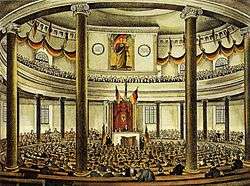Germania (painting)
.jpg)
Germania.

Frankfurt Parliament meeting in the Paulskirche decorated with the painting in 1848/49 (coloured, contemporary engraving). The yellow color on flag is contemporary imagination
Germania is a painting by Philipp Veit created in March 1848 during the Revolutions of 1848. This allegorical figure is represented with the imperial Eagle, oak leaves (symbols of German strength), a hemp branch (as a sign of peace), and a banner.
It was hung in the National Assembly in Frankfurt's Paulskirche, where it concealed the organ. It was meant as a symbol of a united democratic Germany and remained a national personification until the end of World War I.
Germania has been placed in the Germanisches Nationalmuseum in Nuremberg since 1867.
Other Symbolism
- Unfettered Shackle
- While shackles are a symbol of restriction or internment, unfettered shackles are a symbol of freedom, independence, or a new beginning. In national personification, this would indicate past control by another power or nation; either Rome historically, or more specifically, the Holy Roman Empire. See Germany: History However, this was most likely a symbol of the defeat of Napoleon Bonaparte after his Conquest of Europe, of which largely sparked the nationalism that led to the German Revolution of 1848.
- Colors
- Note the prominent black, red and gold flag, which is still in use as the flag of Germany.
- Brandished Sword
- In this figure, the sword is brandished and held upright, in a gesture of leadership and defense, rather than offense or attack. Nobility, justice and truth are represented.
See also
| Wikimedia Commons has media related to Germania (personification). |
This article is issued from Wikipedia - version of the 10/13/2016. The text is available under the Creative Commons Attribution/Share Alike but additional terms may apply for the media files.